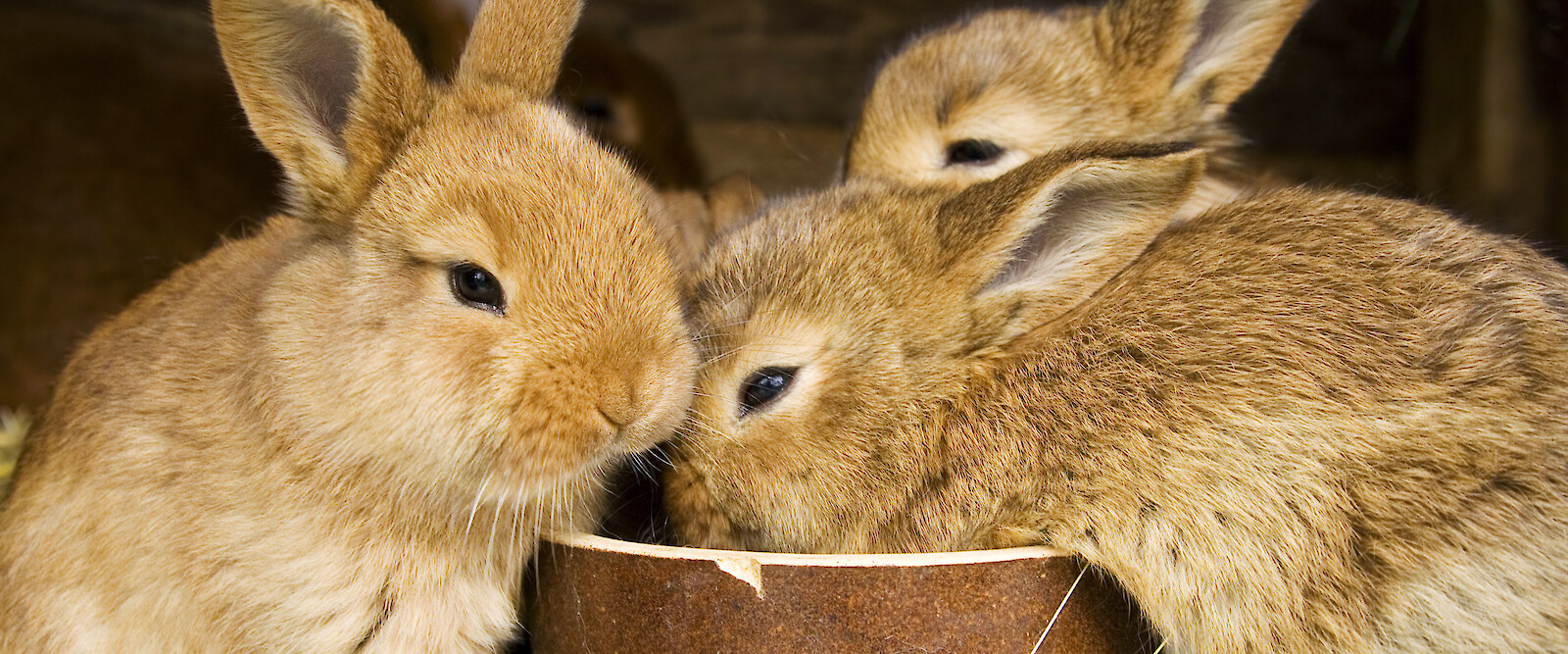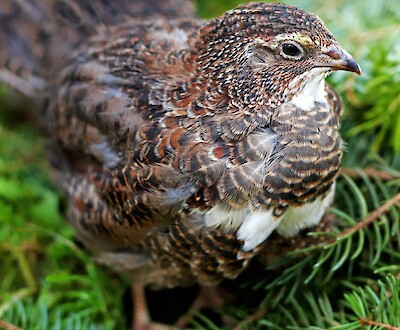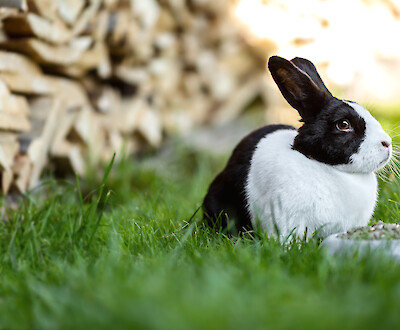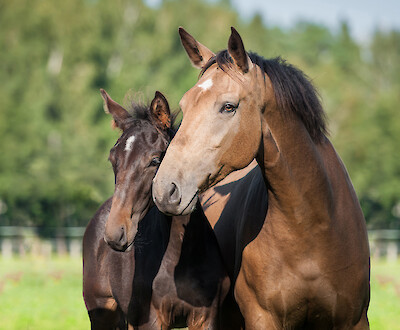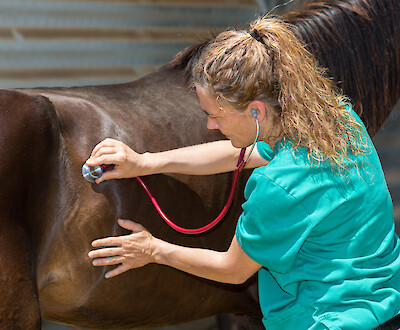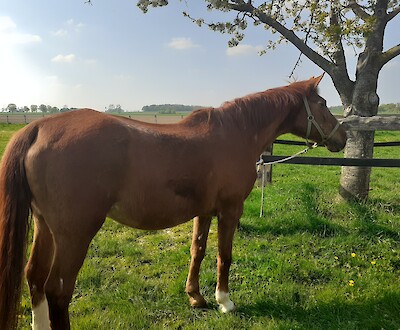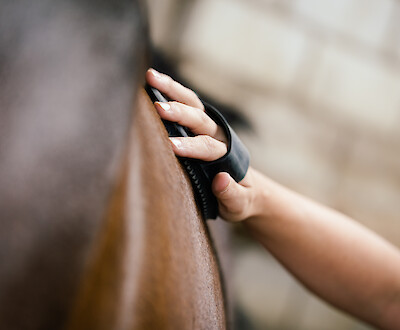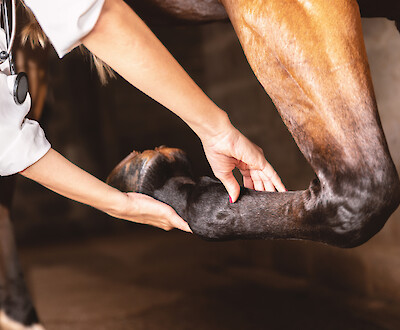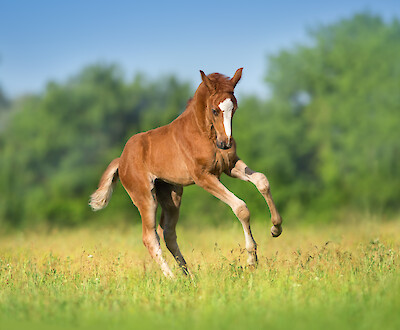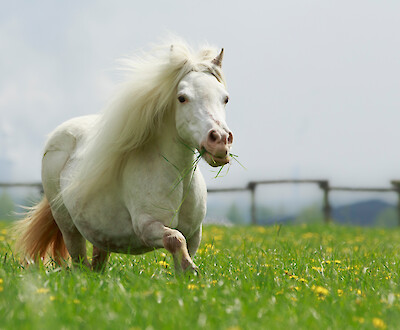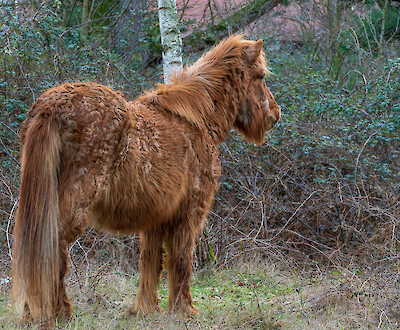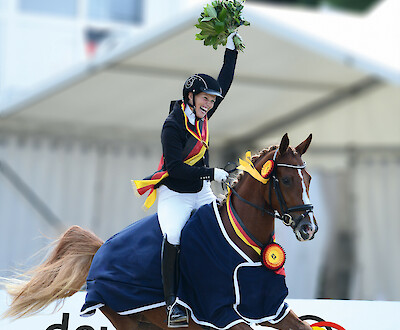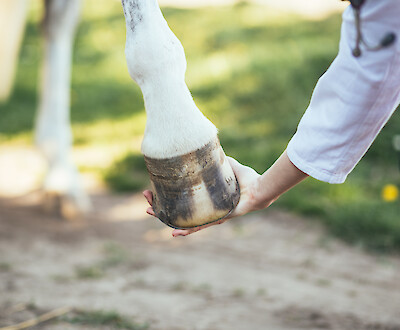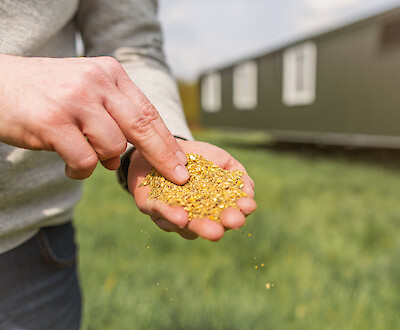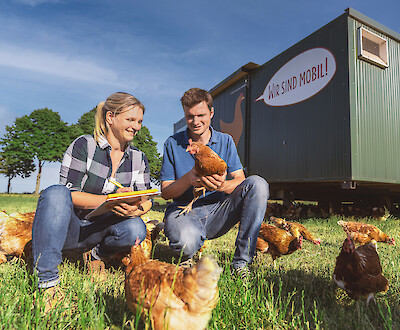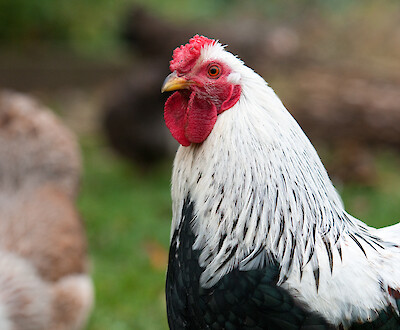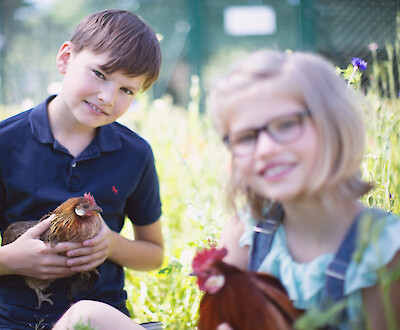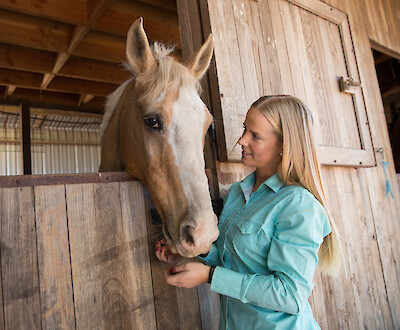Needs-based supply of young animals for more growth and vitality
How to feed young rabbits correctly during weaning
The weaning phase means big changes for young rabbits. With the addition of solid food, the digestive tract of the young animals adapts to new food sources within a short time. The change from colostrum or breast milk to solid food means stress, as the young animals' gastrointestinal tract is not yet fully developed. In order to make the transition easier for the young rabbits and at the same time provide them with all the vitamins and nutrients necessary for their development, feeding them specially adapted weaning feed is suitable during this critical phase.
Weaning: Switching from colostrum to complete rabbit food
The first weeks of life of young rabbits can be roughly divided into two phases: In the suckling phase (week 1-4), the mother's milk ensures the supply of vitamins and minerals to the young animals. In particular, the colostrum (syn. colostrum, first milk or colostrum), which the doe gives to the young in the first three days of life, provides the offspring, who are born without antibodies, with vital immunoglobulins or antibodies.
With the decline of the mother's milk production and the steady development of the digestive organs, the so-called weaning phase begins at the end of the first month of life. During this period, in addition to colostrum, young rabbits take in solid food for the first time and begin to drink water. The proportion of food and water to the mother's milk continues to increase in the following weeks. After about eight to nine weeks, the rabbits are completely weaned.

Adjustment of the gastrointestinal tract of young rabbits during the weaning phase
The transition from mother's milk to solid food is a critical period in the life of young rabbits. The functioning of the digestive system of growing animals at the end of the suckling phase still differs significantly from fully developed adult rabbits. The change from milk to solid food and water is accompanied by extensive anatomical and physiological changes in the entire digestive system.
Change in the digestive cycle during the weaning phase
-
During the suckling phase, the mother rabbit supplies her young with vital vitamins and minerals through the mother's milk. In the first three days of life, colostrum also provides the urgently needed defence substances in the form of "immunoglobulins" to protect against diseases. Since the gastrointestinal tract of the young animals is not used to foreign milk substances during this time, the animals cannot yet sufficiently digest starch and sugar in the small intestine. The proportion of lactose-degrading enzymes continuously decreases parallel to the intake of solid food. At the same time, the amount of starch- and sugar-splitting enzymes gradually increases. If young rabbits ingest large amounts of starchtoo early, they cannot digest it completely in the small intestine. As a result, undigested starch can enter the not yet fully developed large intestine, where it can lead to faulty fermentation. Damage to the intestinal mucosa and inflammation are possible and stressful consequences.
With the intake of solid food, the composition and number of microorganisms in the large intestine also changes. The totality of bacteria is called the intestinal microbiome or intestinal flora for short. Parallel to the constant change of the intestine, the change to solid food must also take place continuously.
-
The different segments of the gastrointestinal tract are developed to different degrees at birth. Measured against the body weight of the rabbit, the stomach makes up a comparatively large proportion in the first weeks of life. In contrast, the small and large intestines are not yet fully developed. This only changes during the weaning phase.
Rabbits - just like horses - are so-called large intestine perennials. This means that they get a large part of their energy from the decomposition of plant food components with the help of intestinal bacteria. The last segment of the intestine is therefore particularly important for the rejection of food and accounts for a large proportion of the total volume of the gastrointestinal tract in adult animals. Immediately after birth, the large intestine is little developed. However, already a few days after birth, a strong growth of the small and large intestine starts - parallel to the change of the microbiome in the intestine of the animals.
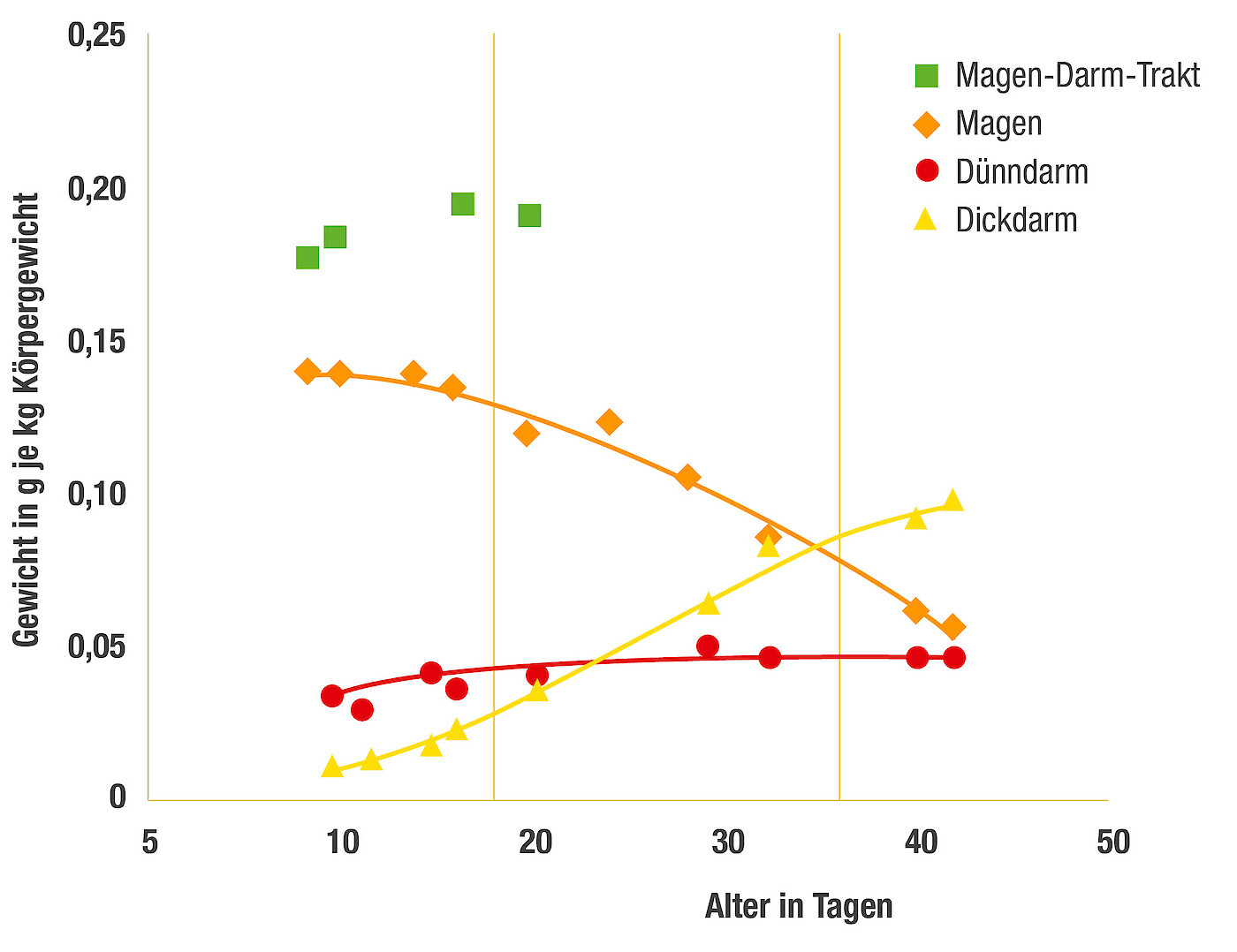
Shortly after birth, a phase of growth and development of the small and large intestine begins. The proportion of the already well-developed stomach in relation to the body weight subsequently decreases more and more (after: de Blas, C. & Wiseman, J: 2020; © Deutsche Tiernahrung Cremer).
Special weaning feeds ensure the supply of young rabbits
The weaning phase is a critical period in the development of young rabbits. The physical changes and the change in food intake stress the organism of the still weak animals. This increases the susceptibility to gastrointestinal diseases such as diarrhoea, flatulence or constipation. The aim of weaning feed must therefore be to make the changeover as easy as possible for them. At the same time, suitable feed must provide the young animals with all the vitamins (especially vitamin A and vitamin D) and minerals (e.g. calcium and phosphorus) they need for their development.
Special weaning feeds - also known as starter feeds - are suitable for this purpose. The ingredients of such pellet feeds are based on the special vitamin and nutrient requirements of young rabbits in this critical phase of life. Such feeds (e.g. deukanin fit herbs & parsley) have a low starch content ofless than 14%. The small amount can be optimally digested in the small intestine. At the same time, weaning feeds have a high content of raw fibres. These plant fibres have a beneficial effect on digestion and serve as an important source of energy for the intestinal bacteria.
Mix of raw fibres promotes intestinal health
However, using only the crude fibre content to evaluate the feed - as often recommended in the past - is misleading. Individual fibre fractions can have large differences in their effect on digestion. Therefore, a mix of different fibre fractions (e.g. mannan-oligosaccharides, lignocellulose) has a particularly beneficial effect on digestion and stimulates the intestinal flora. In this way, a sufficient energy supply can be ensured and at the same time digestive disorders during the already stressful weaning phase can be reduced.
Mannan-oligosaccharides as a protective film against pathogenic germs
Especially fibres from the cell wall of brewer's yeast, mannan-oligosaccharides (MOS), have proven to be a targeted supplement to starter feeds. These fibres belong to the group of indigestible structural carbohydrates - better known as prebiotics. They strengthen the intestinal flora and have a regulating effect against pathogenic germs in the intestine. At the same time, they form a protective film on the intestinal mucosa, which counteracts the attachment of harmful germs and their penetration into the organism.
Safely through the weaning phase with the Prodigest concept
The combination of reduced starch content, high crude fibre content, different fractions of digestible plant fibres as well as the addition of digestive herbs and vitamin C, which strengthens the immune system, is reflected in the so-called Prodigest concept. This concept is characterised by weaning feed (e.g. deukanin fit herbs & parsley) that is especially suitable for young animals. With its precisely adjusted raw fibre structures and a reduced starch content, it optimally supports the vitality of the animals in the weaning phase and subsequent rearing. The extra vitamin C, the encapsulated feed acids to stabilise the pH value in the rear intestinal area as well as the special herbal supplements have a positive influence on the health of the animals. After successful weaning, breeders can now switch the young animals to a follow-up feed (e.g. deukanin dwarf feed or deukanin basis plus).
Conclusion
- Weaning is a critical period of change for young rabbits.
- The digestive tract adapts from digesting colostrum or breast milk to solid food in just a few weeks.
- During the stressful weaning phase, gastrointestinal disorders can easily occur.
- Special weaning foods or starter foods (e.g. deukanin fit herbs & parsley) are optimally adapted to the needs of young rabbits.
- Rabbit owners and breeders should choose a product with the Prodigest concept when buying feed.
- After successful weaning, breeders can now switch the young animals to a follow-up feed (e.g. deukanin dwarf feed or deukanin basis plus).
Image source: © Vera Kailova - stock.adobe.com (top slider)
Contact person

Theresa Oesterwind
Contact person



